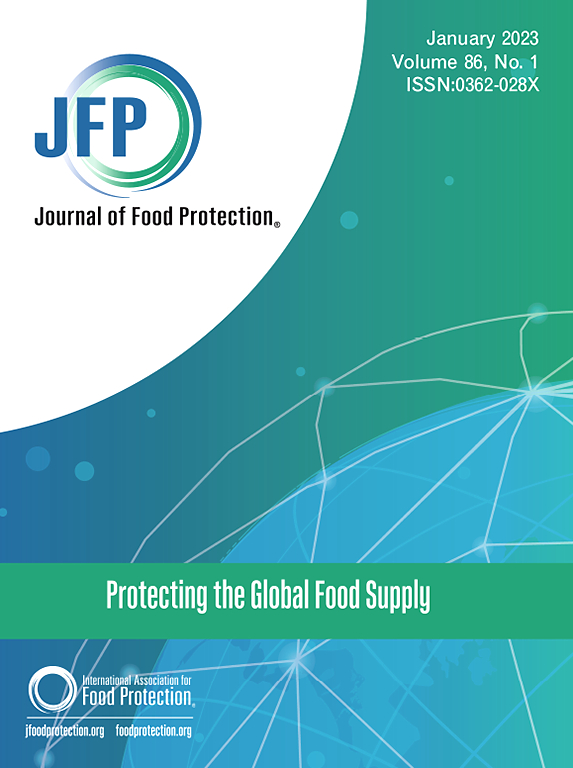Traceback and Testing of Food Epidemiologically Linked to a Norovirus Outbreak at a Wedding Reception
IF 2.1
4区 农林科学
Q3 BIOTECHNOLOGY & APPLIED MICROBIOLOGY
引用次数: 0
Abstract
We investigated a suspected norovirus outbreak associated with a wedding reception in Wisconsin in May 2015. Fifty-six of 106 (53%) wedding attendees were interviewed, and 23 (41%) reported symptoms consistent with norovirus infection. A retrospective cohort study identified fruit salad as the likely vehicle of infection (risk ratio 3.2, 95% confidence interval 1.1––8.3). Norovirus was detected by real-time reverse transcription polymerase chain reaction (RT-qPCR) in stool specimens collected from four attendees and one food handler and in 12 leftover fruit salad samples from both an opened and a sealed container. Norovirus-positive clinical samples (n = 4) were genotyped as GII.4 Sydney and norovirus-positive fruit salad samples (n = 2) confirmed the presence of GII.4 norovirus by Sanger sequencing with 98% nucleotide (n = 236) similarity in 5′ end of ORF2 between fruit salad and clinical specimens. In conclusion, this comprehensive norovirus outbreak investigation combined epidemiologic, virologic, and environmental findings to traceback the contaminated food as the source of the outbreak.
追踪和检测与婚宴上爆发的诺如病毒流行病学相关的食品。
我们调查了与 2015 年 5 月威斯康星州一场婚宴有关的疑似诺如病毒疫情。106 名婚礼参加者中有 56 人(53%)接受了访谈,23 人(41%)报告了与诺如病毒感染相符的症状。一项回顾性队列研究确定水果沙拉可能是感染的媒介(风险比 3.2,95% 置信区间 1.1-8.3)。通过实时反转录聚合酶链反应(RT-qPCR),从四名与会者和一名食品处理人员的粪便标本中,以及从打开和密封容器中的 12 份剩水果沙拉样本中检测到了诺如病毒。诺如病毒阳性的临床样本(4 份)被基因分型为 GII.4 Sydney,诺如病毒阳性的水果沙拉样本(2 份)通过 Sanger 测序证实了 GII.4 诺如病毒的存在,水果沙拉和临床样本 ORF2 5' 端 98% 的核苷酸(236 个)相似。总之,此次诺如病毒疫情综合调查结合了流行病学、病毒学和环境调查结果,追溯了受污染食品的疫情源头。
本文章由计算机程序翻译,如有差异,请以英文原文为准。
求助全文
约1分钟内获得全文
求助全文
来源期刊

Journal of food protection
工程技术-生物工程与应用微生物
CiteScore
4.20
自引率
5.00%
发文量
296
审稿时长
2.5 months
期刊介绍:
The Journal of Food Protection® (JFP) is an international, monthly scientific journal in the English language published by the International Association for Food Protection (IAFP). JFP publishes research and review articles on all aspects of food protection and safety. Major emphases of JFP are placed on studies dealing with:
Tracking, detecting (including traditional, molecular, and real-time), inactivating, and controlling food-related hazards, including microorganisms (including antibiotic resistance), microbial (mycotoxins, seafood toxins) and non-microbial toxins (heavy metals, pesticides, veterinary drug residues, migrants from food packaging, and processing contaminants), allergens and pests (insects, rodents) in human food, pet food and animal feed throughout the food chain;
Microbiological food quality and traditional/novel methods to assay microbiological food quality;
Prevention of food-related hazards and food spoilage through food preservatives and thermal/non-thermal processes, including process validation;
Food fermentations and food-related probiotics;
Safe food handling practices during pre-harvest, harvest, post-harvest, distribution and consumption, including food safety education for retailers, foodservice, and consumers;
Risk assessments for food-related hazards;
Economic impact of food-related hazards, foodborne illness, food loss, food spoilage, and adulterated foods;
Food fraud, food authentication, food defense, and foodborne disease outbreak investigations.
 求助内容:
求助内容: 应助结果提醒方式:
应助结果提醒方式:


